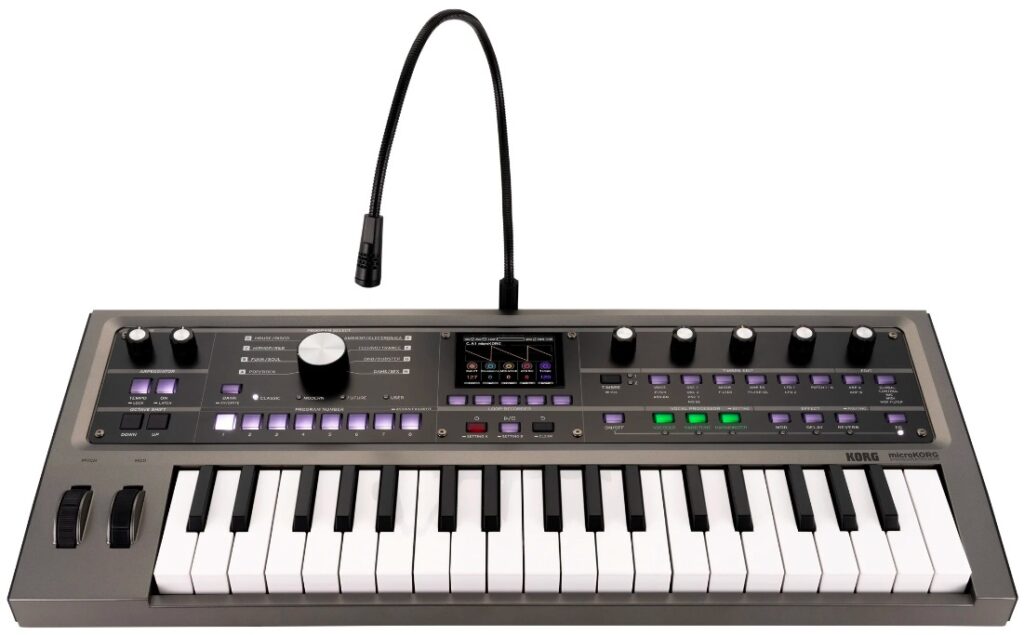Korg’s legendary virtual analogue synth gets a major update. Greg Scarth finds out if the new model is still the go-to for versatile sounds.

It seems hard to believe that the original MicroKorg is over 20 years old now, but Korg’s groundbreaking virtual analogue synth casts a long shadow over everything else which has followed in the two decades since its release. The MicroKorg was released before the subsequent hype around old-school analogue instruments, and instead used more accessible (and affordable) digital techniques to create a wide range of keyboard sounds from vintage synths through to modern tones. The new Korg MicroKorg 2 is very much in the same vein, but substantially more advanced than the original instrument. The big question is whether the MicroKorg ethos is still relevant in 2025 and beyond.

The MicroKorg 2 is a major update based on a similar concept to the original: polyphonic, virtual analogue synthesis designed around immediate controls, quick access to a wide range of sounds and . If you’re an existing MicroKorg owner then, yes, the short answer is that it’s worth upgrading. If you’re a newcomer to hardware synths – like so many buyers of the original MicroKorg were back in the early 2000s – then is the mk2 model still a worthy contender?
The MicroKorg 2 design is very much an evolution of the original model, incorporating features from 2009’s MicroKorg XL as well as plenty of new ideas to keep the design relevant for today’s musicians. In the finely honed, 37-key format you’ve got five octaves of responsive, easily playable mini keys presented below a clear, fairly simple control panel. A swan-neck condenser microphone is included which can be used with the synth’s vocal processing features.

Getting started with the MicroKorg 2 is a simple process. Power comes via a DC adapter, then all that’s required is to plug in a pair of headphones or connect to a suitable amplifier or speakers. With that done, you’re good to go. The major appeal of the MicroKorg is its immediacy and user-friendliness, rather than an obsession with ultimate synth power. As such, it’s perfectly valid to explore the vast range of preset sounds on offer. Korg are experts at developing presets for their instruments which truly capture the sound of contemporary music styles. You’ll quickly find with the MicroKorg 2 that these aren’t lazy pastiches of recognisable sounds but authentic recreations of everything from basslines to strings.
Presets are grouped into eight categories: Pop/Rock, Funk/Soul, Hiphop/R&B, House/Disco, Ambient/Electronica, Techno/Trance. DnB/Dubstep and Game/SFX. Each of those eight categories has four banks: Classic, Modern, Future and User. Each bank has eight programs, giving immediate access to a total of 256 sounds without having to dig through menus.
Manipulating the sounds themselves is also easy, thanks to six rotary knobs assigned to key parameters for each preset. The 2.8-inch colour display gives excellent feedback on which parameters you’re adjusting and how they affect the sound, including the option of visualising waveforms using an oscilloscope view. You don’t necessarily need to dig too deep into the fundamental parameters of the synth engine – oscillator settings, filters, envelope generators and so on – but everything is accessible via the Timbre Edit buttons below the main six parameter knobs.

Once you start to explore the deeper options of the MicroKorg 2, you discover that it follows in the footsteps of the original model by finding a neat balance between immediate accessibility and creative versatility. In addition to the excellent synth engine and effective mod/delay/reverb effects, key features of the MicroKorg 2 include a creatve loop recorder option and those extensive vocal processing tools, which surpass the more basic vocoder features of the original model. Even if you’re a complete newcomer to keyboards or synths, it’s reassuring to know that the MicroKorg 2 has industry-standard compatibility with other music gear, including MIDI in and out (to play with other synths, sequencers, drum machines and the like) and a USB connection.
For the initial release, there’s a standard silver model available plus limited-edition white and black models. The latter are slightly more expensive, but do include a matching soft case to help justify the higher price tag. At just under £450 for the standard model, the MicroKorg 2 is great value. It’s not the cheapest synth on the market, but it’s one which strikes a great balance of playability and professional sound, following in the footsteps of its iconic older sibling.
Greg Scarth
More info/buy